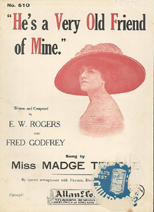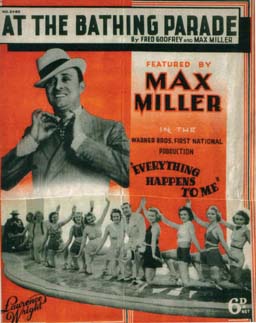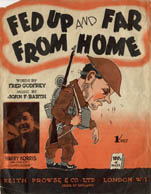What’s New
Posted January 29, 2009
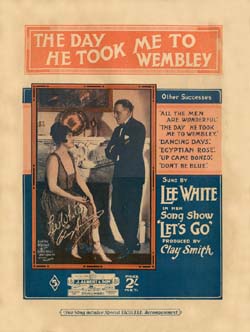 Godfrey Songs on the
West End London Stage
Godfrey Songs on the
West End London Stage
In the mid-1920s, Fred Godfrey found success as a lyricist for “Let’s Go,” a revue staged by the American husband-and-wife Vaudeville team of Lee White (1886–1927) and Clay Smith (1885–?) at London’s Ambassadors Theatre. “Let’s Go” featured Lee White singing the songs, while Clay Smith wrote the music and produced the show. White and Smith, who are credited with giving Gertrude Lawrence her big break in show business, at one time owned and operated London’s famous Strand Theatre (now the Novello Theatre, named after songwriter Ivor Novello, who, like Godfrey, was born in Wales). Sadly, Lee White died, after a series of operations, in Washington, DC, in 1927. Reproduced here is the cover of an Australian songsheet from the revue, which White and Clay staged at the Melbourne Athenaeum Theatre during their successful 1925 Down Under tour. A review in The Argus (Melbourne), June 29, 1925, noted:
“Let’s Go” is an appropriate title, for the revue moves with amazing speed....There is no attempt to be serious, the comedy is clever, and the songs have a merry lilt....One remembers first the songs at the piano by Miss White and Mr. Smith, most of them new, some of them old...but all delightful.
Now-demolished Wembley Stadium was the marvel of its day when it was built for the British Empire Exhibition in 1924.
I am grateful to the website http://www.brucebairnsfather.org.uk and to the book Horses Don’t Fly: A Memoir of World War I, by Frederick Libby (New York: Arcade, 2000), for information on Lee White and Clay Smith.
Posted May 16, 2008
The Wonder Down Under
Ever since this researcher spotted some reproductions of the archival holdings of the National Library of Australia in the marvelous 1982 discography by Frank Andrews and Ernie Bayly of Australian-born Music Hall and recording star Billy Williams, for whom Fred Godfrey wrote so much material, the NLA has been a goldmine of information about Godfrey and his songs. The basis of the NLA’s Godfrey-related holdings was the collection of material bequeathed to it by Billy Williams’s widow, Amy Jennings, much of which is now in the author’s possession, having been de-accessioned by the Australian National Film and Sound Archive after the NLA moved the collection to the latter institution. But the NLA also holds a collection of sheet music from Australian music publishing companies that is a testament to the broad popularity of Godfrey’s songs throughout the British Empire in the early years of the twentieth century. Reproduced below are the covers of two such songs that the NLA has displayed on its website (with my enormous gratitude).
http://nla.gov.au/nla.mus-an10029894 |
http://nla.gov.au/nla.mus-an11556956 |
“The Cheeky Chappie” Sings Godfrey
Beloved British comedian Max Miller, “The Cheeky Chappie” (1894–1963), was known mostly for his slightly risqué stage shows and recordings, but he also made a few films in the 1930s, among which is 1938’s “Everything Happens To Me,” featuring Max’s hijinks at the seaside. Fred Godfrey wrote the title song, which Max also sings to himself as he settles in to sleep in his car on the beach. Godfrey also contributed the music for the big production number At The Bathing Parade, which Max sings to an audience as he introduces a parade of young lovelies in old and new bathing styles, followed by an extended dance routine. I am grateful to the Max Miller Appreciation Society for permission to reproduce the image below.
Happy St. Paddy’s Day!
Fred Godfrey liked to claim that his mother was Irish — and why not? It wasn’t true (his ancestry was Welsh and English), but it helped him sell a few “Irish” songs over the years, including these examples:
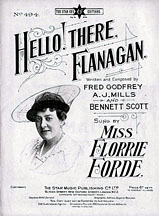 |
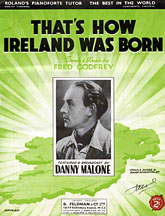 |
And don’t forget, It Takes An Irish Heart To Sing An Irish Song! MP3
Posted August 14, 2007
“Blighty” in the Trenches
A visit last March to the Canadian War Museum in Ottawa revealed a wonderful surprise: in the World War One display, an old postcard showing Tommies in the trenches listening on a portable gramophone to one of Fred Godfrey’s most famous songs, Take Me Back To Dear Old Blighty. The museum has kindly granted permission to reproduce this evocative bit of ephemera — just click on the song title and scroll down until you get to the list of known recordings.
Posted January 13, 2007
Fred Godfrey the Performer
Like most British songwriters, Fred Godfrey spent his professional career in the shadows so far as the public was concerned. Few of the hundreds of thousands who bought sheet music with his name on it — and in large type, too — would have noticed it as they glanced at the performer’s picture on the cover before opening the songsheet on the piano stand.
Yet songwriters occasionally are persuaded to step out of the wings and take a bow. Indeed, some songwriters have been absolute hams about performing. And here I don’t mean people like Harry Lauder, who was known primarily as a performer but who wrote his own material — once uncommon, though standard practice for more than four decades now. But composer and brilliant pianist George Gershwin was notorious for insisting on playing his own stuff anywhere and everywhere, to everyone’s great delight (brother Ira the lyricist, in contrast, preferred to stay well out of the limelight). Hoagy Carmichael, Johnny Mercer, Noël Coward, and Sammy Fain (“The Crooning Composer”) are other songwriters who sought the public’s attention via stage, screen, and recording studio. Perhaps they wanted a taste of what it was like for themselves, rather than just writing for the stars.
Fred Godfrey’s turn in the spotlight came around 1930, when he was persuaded to team up with Irish tenor Tom E. Finglass to put on a Variety act featuring Godfrey’s hits, with Finglass doing the singing while Godfrey accompanied on the piano. The act successfully toured the provincial Music Halls for a few weeks, until Godfrey’s impatience with a life of strict timetables brought it to an end.
Not much is yet known about this episode — when and where the act played still have to be pinned down. Just recently, however, a couple of interesting items emerged from the dusty family archives. One is a publicity photograph for an unknown local newspaper showing Godfrey and Finglass in the company of fellow headliners Shaun Glenville, midget performer Wee Georgie Wood (whom John Lennon jokingly refers to as the writer of “Dig It” on The Beatles’ Let It Be album), and singer Florence Oldham (see below).
| Unidentified newspaper clipping from about 1930; |
The other item is a gushing newspaper review of the act as it appeared at the Exeter Hippodrome on the night of November 11, 1930:
The presence on stage of Fred Godfrey, the author of “Take Me Back To Dear Old Blighty,” gave rise to scenes of remarkable enthusiasm at Exeter Hippodrome last night, and the audiences at both houses revelled in the popular war-time chorus, the singing of which, however, was tinged with a feeling of sadness. Rarely, if ever, has there been a more unique occasion at the Hippodrome. Apart from the atmosphere engendered by the appearance on the stage on Armistice Night of the man who wrote a ditty that will always be associated with memories of the war, the popularity of many other songs composed by Fred Godfrey was made manifest, these including “Who Were You With Last Night?” and “Down Texas Way.”....Tom E. Finglass, who has been associated with most of these hits, sang many old favourites in characteristic style, and introduced a topical number based on a ditty that has recently been in great favour. Fred Godfrey was at the piano. The show is brimful of originality and mirth.
Posted September 1, 2006
Blind Alleys
As an example of the blind alleys that await the researcher, here is the story of The Three Freds.
An online search of the sheet music holdings of the Bodleian Library, Oxford, revealed the existence of a World War One–era song called When You Have Time To Remember, written by Fred Gibson and performed by The Three Freds, whom the catalogue identified as Fred Gibson, Fred Godfrey, and Fred Wildon. Aha! So Fred Godfrey was part of a musical act years before his brief appearance on the Variety stage with Irish tenor Tom E. Finglass around 1930. I couldn’t imagine him singing, let alone harmonizing, but perhaps he accompanied the other two Freds on the piano.
The next step, of course, was to look at a copy of the original sheet music — perhaps a cover photo would reveal all. And fortunately, a copy has just recently come into my hands. Alas, no cover photo, but, sure enough, there is Fred Godfrey’s name down as one of The Three Freds. It was only when I opened the sheet music to page 2 that my crest fell. Here, Fred Godfrey becomes Fred Gregory, undoubtedly the true second Fred.
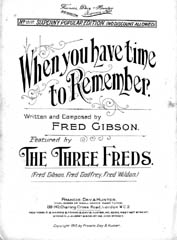 |
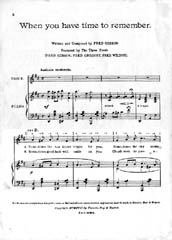 |
The likely explanation is that the printers must have become so used to seeing “Fred Godfrey” on the hundreds of Feldman, Star, and Francis Day & Hunter sheets they were handling each year that they became confused after already putting in “Fred Gibson” (twice!), and when they saw another “Fred G...” coming up, they typeset Godfrey’s name out of habit. It’s easy to do!
So, no humming, yodeling, or vamping Fred Godfrey. It was for others to make his songs renowned.
Also new is the music sheet shown at left. Fed Up And Far From Home is a typical example of the “Services” songs for which Fred Godfrey became known.
Even before the outbreak of World War One, Godfrey had written songs like Ev’ry Girl Loves A Military Man! (with John P. Harrington & Orlando Powell, 1910); Why Can’t The Girls Be Soldiers? (with John Neat, 1911); and Oh! The Sailors Of The King (with Billy Williams, 1912). During the Great War came such titles as Follow The Sergeant (with A.J. Mills & Bennett Scott, 1915); Mister Sergeant Michael Donoghue (with Tom Mellor & Harry Gifford, 1915); and There’ll Be Nothing But Boys In Khaki By The Seaside (with Raphael Penso & Lawrence Wright, 1915). During the interwar years, Godfrey had a hit with Skin-A-Ma-Link The Sergeant (1931).
Then, in World War Two came the publication of Fred Godfrey’s most famous Services song, Bless ’Em All. On the strength of that enormous hit, George Formby Jr. asked Godfrey to supply him with more ditties about the boys in uniform, and along came Out In The Middle East (1942); Home Guard Blues (with Formby & Fred E. Cliffe, 1942), recorded by Formby and sung by him in the film Get Cracking (1943); and even Mister Wu (Is In The Chinese Navy Now) (with Formby, 1944).
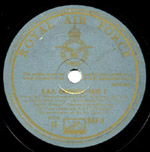 The music to Fed Up And Far From Home was originally written by American composer John Frederic Barth and published in Cleveland by Sam
Fox Publishing in 1910. Perhaps because it had omitted Godfrey’s name from the printed sheet music of Bless ’Em All, in 1941 Keith Prowse Music dusted off the old melody and asked Godfrey to write new lyrics for the new conflict. Performed over the radio, Fed Up And Far From Home became a minor singalong hit. The only known recording, however, is in a medley of choruses for an RAF charity disc, as shown.
The music to Fed Up And Far From Home was originally written by American composer John Frederic Barth and published in Cleveland by Sam
Fox Publishing in 1910. Perhaps because it had omitted Godfrey’s name from the printed sheet music of Bless ’Em All, in 1941 Keith Prowse Music dusted off the old melody and asked Godfrey to write new lyrics for the new conflict. Performed over the radio, Fed Up And Far From Home became a minor singalong hit. The only known recording, however, is in a medley of choruses for an RAF charity disc, as shown.
.jpg) |
Posted January 8, 2006
With many thanks to Peter Burgis, former head of Australia’s National Film and Sound Archive, here is a long-lost photograph of a dapper Fred Godfrey, taken around 1910.
Among the many stars who sang Godfrey’s songs were two once-popular but now largely forgotten duos whose photographs are featured on the songsheets below. In the mid- to late 1920s, the husband-and-wife team of soprano Irene Hill and tenor Ellis Vizard sang Gilbert & Sullivan as part of the D’Oyly Carte Opera Company. By 1930, the date of A Dream Of Asia, the two had left D’Oyly Carte for Variety and, one supposes, radio, but information on them is hard to find.
Also featured is the brother act of Bob and Alf Pearson, from the northeastern English city of Sunderland, who first became popular in the early 1930s. Their fame soared in the 1940s and ’50s, when millions of Britons heard them regularly on the radio. Bob died in 1985, but Alf is still going strong and, in 2004, at age 94, released a CD of the brothers’ songs. The Godfrey songsheet shown below is from 1931, when Bob and Alf were just beginning their rise to stardom.
Finally, for fans of the great Australian star of the Music Hall, Billy Williams, “The Man in the Velvet Suit”, reproduced here is a colourful Australian edition of one of Billy’s lesser-known hits, My Father Was Born In Killarney, from 1911. The cover suggests that other artists also sung the song with success.
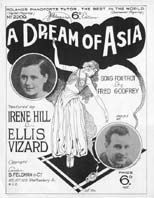 |
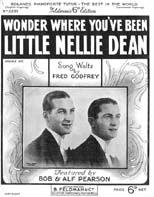 |
 |
Just come to light: several new songs from 1907 by Fred Godfrey and John Neat, co-writer of that year’s huge hit, She’s A Lassie From Lancashire, which Godfrey also claimed to have written but for which he received no credit. Officially, at least, the pair produced Come For A Sail In My Yacht; Good-Night, Mister Kangaroo!; A Hundred Years To Come (and wouldn’t it be interesting to see that piece of sheet music now that we are almost there?); The Regimental Pet; and ’Twas An Old, Old Song.
Also just found from 1907 are two songs by Godfrey and Kenneth Lyle: Strolling Along The Sands, and Your Number’s Up. Lyle went on to write hits for Vesta Tilley (Jolly Good Luck To The Girl Who Loves A Sailor, 1910) and Mark Sheridan (Here We Are! Here We Are! Here We Are Again!, 1914).
Here are songsheets featuring two of Fred Godfrey’s friends, Talbot O’Farrell, the faux-Irish tenor from Yorkshire, and the great Australian star, Florrie Forde. The O’Farrell sheet, from 1916, is one of the few that actually specifies Godfrey’s contribution — in this case as lyricist; this copy is signed by co-writer Ronald F. Wakley. Florrie’s song is from 1920. She was past her prime by then, but still a redoubtable presence on the postwar Variety stage. And while we’re on an Australian theme, also shown is a Down Under edition of one of Godfrey’s earliest big hits, Have You Got Another Girl At Home Like Mary?, from 1908.
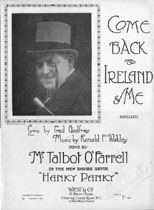 |
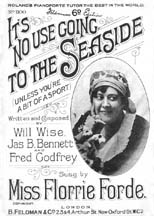 |
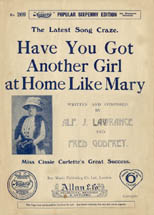 |
For details on these songs, see All the Known Fred Godfrey Songs.
